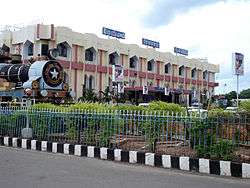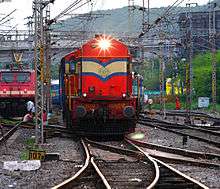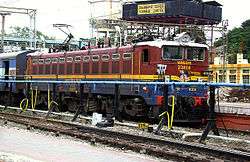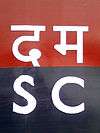Vijayawada Junction railway station
Vijayawada Junction విజయవాడ జంక్షన్ | |||||||||||||||||||||
|---|---|---|---|---|---|---|---|---|---|---|---|---|---|---|---|---|---|---|---|---|---|
 Vijayawada Railway station | |||||||||||||||||||||
| Location |
Railway Station Rd, Hanumanpet, Vijayawada, Andhra Pradesh India | ||||||||||||||||||||
| Coordinates | 16°31′06″N 80°37′10″E / 16.5184°N 80.6195°ECoordinates: 16°31′06″N 80°37′10″E / 16.5184°N 80.6195°E | ||||||||||||||||||||
| Operated by | Indian Railways | ||||||||||||||||||||
| Line(s) | Howrah-Chennai main line, New Delhi-Chennai main line | ||||||||||||||||||||
| Platforms | 10 | ||||||||||||||||||||
| Tracks | 22 | ||||||||||||||||||||
| Construction | |||||||||||||||||||||
| Structure type | Standard (on ground station) | ||||||||||||||||||||
| Parking | Yes | ||||||||||||||||||||
| Bicycle facilities | Yes | ||||||||||||||||||||
| Disabled access |
| ||||||||||||||||||||
| Other information | |||||||||||||||||||||
| Station code | BZA | ||||||||||||||||||||
| Zone(s) | South Central Railway | ||||||||||||||||||||
| Division(s) | Vijayawada | ||||||||||||||||||||
| History | |||||||||||||||||||||
| Opened | 1888 | ||||||||||||||||||||
| Traffic | |||||||||||||||||||||
| Passengers | 51 millions approx. | ||||||||||||||||||||
| Services | |||||||||||||||||||||
| |||||||||||||||||||||
Vijayawada railway station is an Indian railway station in Vijayawada of Andhra Pradesh. It is the second busiest railway junction of Indian Railways, next to Mumbai Central and is situated on the mutual lines of Howrah-Chennai and New Delhi–Chennai main lines.[1] The station is the divisional headquarters of Vijayawada railway division in South Central Railway zone.[2][3]
Vijayawada railway station is categorized as an A-1 station and also one of the ten model stations in the Vijayawada division.[4] It is also one of the busiest railway stations in India with over 400 trains of freight and passenger pass through it and serving about 1.40 lakh passengers everyday.[1][5]
History

_Satavahana_Express_at_Vijayawada.jpg)
The Vijayawada railway station was constructed in 1888 when the Southern Maharatta Railway's main eastward route was connected with other lines going through Vijayawada. In 1889, the Nizam's Guaranteed State Railway constructed a line between Secunderabad Railway Station and Vijayawada as an extension railway for Bezawada; the station subsequently became a junction of three lines from different directions.
On 1 November 1899, the broad gauge line was constructed between Vijayawada and Chennai, making rail journey between Chennai, Mumbai, Howrah, New Delhi and Hyderabad possible. In the following decades the Vijayawada railway station was developed into a junction until the nationalisation of all the independent railways in India occurred; following nationalisation, Indian Railways was formed under the Ministry of Railways in 1950 by the Government of India. The Vijayawada railway station, as the headquarters of Vijayawada Division, was assigned to the Southern Railway. In 1966, a new zone, South Central Railway, was formed, with Secunderabad as its headquarters; Vijayawada Division and Vijayawada Junction were merged with the new railway.
In 1969, the Golconda Express was introduced between Vijayawada and Secunderabad as the fastest steam-hauled train in the country, with an average speed of 58 km/h. As of 2012, the Vijayawada railway station is one of the busiest railway stations in India.[6]
Layout
Vijayawada station has the standard station layout with a perfect traction inside the station. All the tracks in the station are broad gauge and electrified.
Platforms
The station has 10 platforms and all the tracks are broad gauge. The seventh platform of the station is the largest of all.[7][8]
Junction
Vijayawada station is a junction station for four sections.[2][3] They are:
- Vijayawada-Gudur section
- Vijayawada–Gudivada section
- Visakhapatnam–Vijayawada section
- Kazipet–Vijayawada section
Performance and earnings

| No. of platforms | 10 | |
| Trains | Passenger | 250 |
| Freight | 150 | |
| Passengers | Per day | 1.40 lakh |
| Annual | 50 million | |
An average of 1.40 lakh passengers are served per day and 50 million annually. More than 250 passenger trains and 150 goods trains utilize the station daily, with each train stopping for at least 15 to 20 minutes.[1][9]
The Vijayawada Junction also houses a Diesel Loco Shed which has the WDM-2 Locomotive and also an Electric Loco Shed which has the WAG-7, WAM-4, WAG-5 locos.


Satellite stations
The Vijayawada station has several satellite stations in order to reduce the congestion on the main station. They are:[9][10]
| # | Station Name |
|---|---|
| 1 | Gunadala |
| 2 | Kondapalli |
| 3 | Krishna Canal Junction |
| 3 | Rayanapadu |
| 5 | Gannavaram railway station |
| 6 | Mustabada Station |
| 7 | Uppaluru Station |
| 8 | Ramavarappadu Station[11] |
| 9 | Nidamanuru Station[12] |
| 10 | Madhuranagar Station[13] |
Infrastructure
Since the headquarters of South-East railway moved to Bhubaneswar from Visakhapatnam, Vijayawada Railway station has seen major development and new appearance in the last five years. In the FY 2009, the Indian Railways Company board allocated ₹3.5 crore (US$520,000) for improvements to the transport hub.[14] A central aspect of the improvements was an "Integrated Security Scheme" which included construction of a compound wall around the station premises and a reduction in the number of entrances as a precaution against terrorism.
See also
| Wikimedia Commons has media related to Vijayawada railway station. |
References
- 1 2 3 "Upgraded Gunadala rail station by March". Deccan Chronicle. Vijayawada. 19 June 2013. Archived from the original on 23 June 2013. Retrieved 16 January 2016.
- 1 2 "Profile". South Central Railway. Retrieved 16 January 2016.
- 1 2 "Jurisdiction". www.scr.indianrailways.gov.in. Retrieved 16 January 2016.
- ↑ "Vijayawada Division – a profile" (PDF). Indian Railways. Retrieved 2013-01-25.
- ↑ "Statement showing Category-wise No.of stations" (PDF). Archived from the original (PDF) on 28 January 2016. Retrieved 18 January 2016.
- ↑ "Vijayawada lays platform for Krishna fete". The Hindu. 23 Aug 2004. Retrieved 20 Sep 2012.
- ↑ "Plans to develop railway station". The Hindu. Vijayawada. 24 March 2008. Archived from the original on 7 April 2013. Retrieved 16 January 2016.
- ↑ Murali Sankar, K.N. (12 April 2008). "Railway station sports a new look". The Hindu. Vijayawada. Retrieved 16 January 2016.
- 1 2 "A way out to decongest Vijayawada railway station". The Hindu. Vijayawada. 4 June 2015. Retrieved 16 January 2016.
- ↑ Papasani, Phanindra (29 March 2016). "Four satellite stations and additional 500 trains for Krishna Pushkarams". Times of India. Vijayawada. Retrieved 28 April 2016.
- ↑ Gopi, D (27 March 2016). "Speed up Pushkaram works, says Krishna Collector". Vijayawada. Retrieved 28 April 2016.
- ↑ Gopi, D (7 November 2014). "Facelift for Vijayawada railway junction". Retrieved 28 April 2016.
- ↑ "Plea to develop 3 railway stations for Pushkaram". The Hans India. 8 March 2016. Retrieved 28 April 2016.
- ↑ "Vijayawada railway junction struggles to keep pace with increasing rush". The Hindu. Chennai, India. 10 February 2009.
External links
- South Central Railway
-
 Vijayawada travel guide from Wikivoyage
Vijayawada travel guide from Wikivoyage

